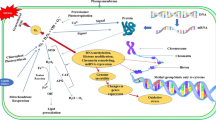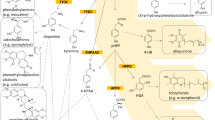Abstract
The function of two proteins (P67 and P100) required for the MgATP-dependent inactivation of nitrate reductase (NR) from spinach leaves (Spinacia oleracea L.) was studied. When NR was incubated with γ-[32P]ATP and P67, NR-protein was phosphorylated, but without a change in NR activity. Protein P100 by itself was neither able to phosphorylate nor to inactivate NR, and when added together with P67 it did not change the extent of NR phosphorylation. However, when NR was first phosphorylated with MgATP and P67, subsequent addition of P100 after removal of unreacted ATP caused an immediate NR inactivation. In presence of both P67 and P100 the time-course of ATP-dependent NR phosphorylation paralleled the time course of inactivation. The extent of NR phosphorylation and of NR inactivation (in the presence of P67 plus P100) was similarly affected by metabolites or high salt concentrations. Magnesium (Mg2+) played a dual role in the inactivation process: the phosphorylation of NR by P67 was strictly Mg2+-dependent. Further, phospho-NR (+P100) was inactive only in the presence of Mg2+, but active in the presence of excess EDTA. Dephospho-NR appeared to be Mg2+-insensitive. The observations suggest that phosphorylation of NR by P67 is obligatory, but not sufficient for inactivation. In addition to protein phosphorylation, inactivation requires “binding” of an inhibitor protein (P100) to phospho-NR.
Similar content being viewed by others
Abbreviations
- G6P:
-
glucose-6-phosphate
- NR:
-
NADH-nitrate reductase
- NRA:
-
nitrate reductase activity
References
Abdel-Ghany, M., Riegler, C., Racker, E. (1984) A placental polypeptide activator of a membranous protein kinase and its relation to histonel. Proc. Natl. Acad. Sci. USA 81, 7388–7391
Glaab, J., Kaiser W.M. (1993) Rapid modulation of nitrate reductase in pea roots. Planta 191, 173–179
Hageman, R.H., Reed, A.J. (1980) Nitrate reductase from higher plants. Methods Enzymol. 69, 270–280
Huber, J.L., Huber, S.C., Campbell, W.H., Redinbaugh, M.G. (1992a) Reversible light/dark modulation of spinach leaf nitrate reductase activity involves protein phosphorylation. Arch. Biochem. Biophys. 296, 58–65
Huber, S.C., Huber, J.L., McMichael, R., Campbell, W.H., Redinbaugh, M.G. (1992b) Regulation of cytoplasmic C- and N-metabolism by protein phosphorylation. In: Research in photosynthesis, vol. III, pp. 675–682, Murata, N., ed. Kluwer Acad. Publ., Amsterdam
Kaiser, W.M., Brendle-Behnisch, E. (1991) Rapid modulation of spinach leaf nitrate reductase by photosynthesis. 1. Modulation in vivo by CO2 availability. Plant Physiol. 96, 363–367
Kaiser, W.M., Förster, J. (1989) Low CO2 prevents nitrate reduction in leaves. Plant Physiol. 91, 970–974
Kaiser, W.M., Huber, S. (1994) Modulation of nitrate reductase in vivo and in vitro: Effects of phosphoprotein phosphatase inhibitors, free Mg2+ and 5′-AMP. Planta 193, 358–364
Kaiser, W.M., Spill, D. (1991) Rapid modulation of spinach leaf nitrate reductase by photosynthesis. II. in vitro modulation by ATP and AMP. Plant Physiol. 96, 368–375
Kaiser, W.M., Spill, D., Brendle-Behnisch, E. (1992) Rapid lightdark modulation of assimilitory nitrate reductase in spinach leaves involves adenine nucleotides. Planta 186, 236–240
Laemmli, U.K. (1970) Cleavage of structural proteins during the assembly of the head of bacteriophage T4. Nature 227, 680–685
Lillo, C. (1994) Light regulation of nitrate reductase in green leaves of higher plants. Physiol. Plant 90, 616–620
MacKintosh, C. (1992) Regulation of the spinach leaves nitrate reductase by reversible phosphorylation. Biochim. Biophys. Acta 1137, 121–126
MacKintosh, R.W., MacKintosh, C. (1993) Regulation of plant metabolism by reversible protein (serine/threonine) phosphorylation. In: Society for Experimental Biology, Seminar Series 53: Post-translational modifications in plants, pp. 197–212, Battey, N.H., Dickinson, H.G., Hetherington, A.M., eds. Cambridge University Press
Riens, B., Heldt, H.W. (1992) Decrease in nitrate reductase activity in spinach leaves during a light-dark transition. Plant Physiol. 98, 573–577
Spill, D., Kaiser, W.M. (1994) Partial purification of two proteins (100 kDa and 67 kDa) cooperating in the ATP-dependent inactivation of spinach leaf nitrate reductase. Planta 192, 183–188
Yamagishi, K., Sato, T., Ogura, N., Nakagawa, H. (1988) Isolation and some properties of a 115-kilodalton nitrate reductase-inactivator protein from Spinacia oleracea. Plant Cell Physiol. 29, 371–376
Yoshimura, T., Sekino, N., Okuo, K., Sato, T., Ogura, N., Nakagawa, H. (1992) A nitrate reductase inactivator protein from spinach. Purification, molecular weight and subunit composition. Plant Cell Physiol. 33, 363–369
Author information
Authors and Affiliations
Additional information
The skilled technical assistance of Elke Brendle-Behnisch is gratefully acknowledged. We also wish to thank Dr. C. MacKintosh, University of Dundee, UK, who supplied us with an immuno-affinity column for NR purification. This work was supported by the Deutsche Forschungsgemeinschaft (SFB 251).
Rights and permissions
About this article
Cite this article
Glaab, J., Kaiser, W.M. Inactivation of nitrate reductase involves NR-protein phosphorylation and subsequent ‘binding’ of an inhibitor protein. Planta 195, 514–518 (1995). https://doi.org/10.1007/BF00195708
Received:
Accepted:
Issue Date:
DOI: https://doi.org/10.1007/BF00195708




